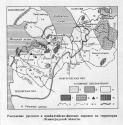|
|
Articles
/
Archaeological monuments
Archaeological monumentsAuthors
Plotkin, Konstantin Moiseyevich
Persons
Brandenburg, Nikolay Yefimovich
Gurina, Nina Nikolayevna Inostrantsev, Aleksandr Aleksandrovich Ivanovsky, Lev Konstantinovich Kirpichnikov, Anatoly Nikolayevich Lebedev, Gleb Sergeyevich Ravdonikas, Vladislav Iosifovich Roerich, Nikolay Konstantinovich Ryabinin, Yevgeny Aleksandrovich Schwindt, Theodor Sorokin, Pyotr Yegorovich Spitsyn, Aleksandr Andreyevich Geography
Leningrad Oblast, the/Volkhov District/Berezye Village
Topographical landmarks/Gulf of Finland, the Topographical landmarks/Izhora Hills, the Topographical landmarks/Izhora River, the Leningrad Oblast, the/Vyborg District/Kamennogorsk Town Leningrad Oblast, the/Vyborg District/Kamennogorsk Town Topographical landmarks/Karelian Isthmus, the Topographical landmarks/Luga River, the Topographical landmarks/Narva River, the Topographical landmarks/Neva River, the Topographical landmarks/Novy Syassky Canal, the Topographical landmarks/Pasha River, the Topographical landmarks/Prichudye North-eastern Leningrad Oblast, the/Luga District/Staberskaya, village Leningrad Oblast, the/Volkhov District/Staraya Ladoga Village Leningrad Oblast, the/Volkhov District/Ust-Rybezhno Village Topographical landmarks/Volkhov River, the Bibliography
Лебедев Г. С. Археологические памятники Ленинградской области. Л., 1977
Кирпичников А. Н. Каменные крепости Новгородской земли. Л., 1984 Кирпичников А. Н., Сарабьянов В. Д. Старая Ладога – древняя столица Руси. СПб. 1996 Рябинин Е. А. Водская земля Великого Новгорода. СПб., 2001. Лапшин В.А. Археологическая карта Ленинградской области. Ч. 1-2. Л.; СПб. 1990-1995 Гурина Н.Н. Древняя история Северо-Запада Европейской части СССР. Материалы и исследования по археологии СССР. № 87. Л., 1961 Subject Index
Burial grounds of the Izhora people.
Burial grounds of the Karelian people. Burial grounds of the Vod people. Culture of Mounds Ivangorod Fortress Koporye Fortress Korela, fortress, the Kurgans (barrows) of the southern Ladoga Lake region. Mesolithic monuments, The. Neolithic monuments, The Oreshek, see Schlusselburg Fortress The Culture of long burial mounds (barrows) Yamgorod Fortress Zhalniks (sepulcrums). Mentioned in articles:
|
|







